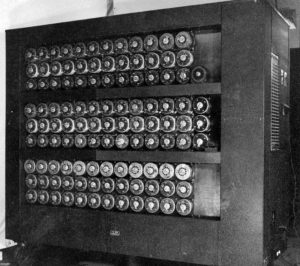Archive of the Teams Behind Major Computer Science Endeavors
Introduction to the Archive
The purpose of this archive is to show that computer science research was never completed by one person. Every discovery has usually been credited to the genius of one individual, whose name will always come up when discussing the creation of a particular technology. Every one of those geniuses was supported by a multitude of people who made their inventions and discoveries possible. In this archive, I will be showcasing the teams who worked on some of the greatest technological inventions from the 20th century to today. I will also be showcasing the workers behind the success of some vital early tech companies. There are very few archives on the subject of early workers and research team members, and this archive serves as a place to give credit to all those who assisted with such revolutionary technologies.
I have gathered most of my photographs from the DPLA and DRS, credit is also included at the bottom of this page. All items in the archive can be found on this page by scrolling down and going through each gallery. Each item is separated with a short description of each collection. To see more about a particular photo or item, click on it.
The Enigma
The gallery to the right is a collection of items from Bletchley Park, the institution where Bombe was created and codebreakers worked on cracking the Engima machine. Most people believe that Enigma was cracked by only a team of a few people, something I believe came from the movie "The Imitation Game." This is actually very inaccurate as over 10,000 personnel worked at Bletchley Park to crack the code during World War II. I have included a picture of the Enigma machine as well as a few correspondences between members. For more information, please click this link here to be brought to Bletchley Park's website where there is more information. I reached out to Bletchley Park to inquire about hosting some of their content in this gallery, but I received no response.
The ENIAC
To the right, you see a collection of ENIAC photos. The ENIAC was an Electronic Numerical Integrator and Computer. This computer was mostly used by women to calculate ballistic firing tables during WWII. The ENIAC is considered to be the first working all electric computing machine. I also found it quite interesting that most of these photos and those above come from dates surrounding WWII. The ENIAC was attributed to John Mauchley and J Presper Eckert but its success can be attributed to the military and all of the operators, mostly female, who worked with the machine.
General Electric
GE was a company that first started in 1892 by Thomas Edison, J.P. Morgan, and a few other fellows. This company was largely the byproduct of Edison's inventions and scientific discoveries. Though the company started out peddling Edison's wares it has grown into many different business sectors today. At one point GE had a thriving computing department in the 1960s, There was also a strike at GE during the same time, of which I have included pictures as well.
IBM
To the left is a collection of photos of IBM employees. IBM is a well-known computer company that developed early computers. IBM created many different innovations such as the hard disk drive and the floppy drive. When most people accredit IBM's success, they think of Thomas J. Watson, the CEO of the company from 1914 to 1956. Watson had thousands of brilliant employees under him that can be accredited with the success of the company today on top of his leadership.
Credit
Credit to DPLA for the use of all photos that are seen here unless otherwise specified.
~This archive was created by Christian Hauser at Northeastern University. Credit to the University and to Professors Elizabeth Dillon and Sarah Connel for their assistance with this project.




